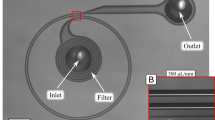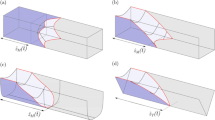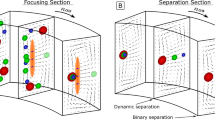Abstract
The demand for techniques that can reliably deliver and control nanometre-scale volumes of liquid is a growing priority in biotechnology and medicine. Capillary jets are capable of supplying a steady stream of monodisperse liquid droplets. But because of the increasing forces and pressures needed to counteract surface tension for droplets of decreasing size, reaching the nanoscale with such an approach is difficult. One way of overcoming such limitations is to electrostatically focus a jet as it emerges from a capillary. Another, which we report here, is to focus such a jet by hydrodynamic means, a double flow-focusing arrangement that involves a manifold capillary that delivers a second immiscible fluid jet that envelopes and guides the jet from an inner capillary. Under the appropriate working conditions, this enables the generation of continuous steady capillary fluid jets down to submicrometre diameter—approaching the ultimate continuum limit, which is supported by a proposed theory.
This is a preview of subscription content, access via your institution
Access options
Subscribe to this journal
Receive 12 print issues and online access
$209.00 per year
only $17.42 per issue
Buy this article
- Purchase on Springer Link
- Instant access to full article PDF
Prices may be subject to local taxes which are calculated during checkout





Similar content being viewed by others
References
Whitesides, G. M. Nanoscience, nanotechnology, and chemistry. Small 1, 176–179 (2005).
Gates, B. D., Xu, Q. B., Love, J. C., Wolfe, D. B. & Whitesides, G. M. Unconventional nanofabrication. Annu. Rev. Mater. Res. 34, 339–372 (2004).
Stone, H. A. Dynamics of drop deformation and breakup in viscous fluids. Annu. Rev. Fluid Mech. 26, 65–102 (1994).
Eggers, J. Nonlinear dynamics and breakup of free-surface flows. Rev. Mod. Phys. 69, 865–929 (1997).
Gañán-Calvo, A. M. Generation of steady liquid microthreads and micron-sized monodisperse sprays in gas streams. Phys. Rev. Lett. 80, 285–288 (1998).
Xu, S. et al. Generation of monodisperse particles by using microfluidics: Control over size, shape, and composition. Angew. Chem. Int. Edn 44, 724–728 (2005).
Suryo, R. & Basaran, O. A. Tip streaming from a liquid drop forming from a tube in a co-flowing outer fluid. Phys. Fluids 18, 082102 (2006).
Taylor, G. I. The formation of emulsions in definable fields of flow. Proc. R. Soc. Lond. A 146, 501 (1934).
Zhang, W. W. Viscous entrainment from a nozzle: Singular liquid spouts. Phys. Rev. Lett. 93, 184502 (2004).
Gañán-Calvo, A. M. & Gordillo, J. M. Perfectly monodisperse microbubbling by capillary flow focusing. Phys. Rev. Lett. 87, 274501 (2001).
Anna, S. L., Bontoux, N. & Stone, H. A. Formation of dispersions using flow focusing in microchannels. Appl. Phys. Lett. 82, 364–366 (2003).
Garstecki, P. et al. Formation of monodisperse bubbles in a microfluidic flow-focusing device. Appl. Phys. Lett. 85, 2649–2651 (2004).
Garstecki, P., Stone, H. A. & Whitesides, G. M. Mechanism for flow-rate controlled breakup in confined geometries: A route to monodisperse emulsions. Phys. Rev. Lett. 94, 164501 (2005).
Takeuchi, S., Garstecki, P., Weibel, D. B. & Whitesides, G. M. An axisymmetric flow-focusing microfluidic device. Adv. Mater. 17, 1067–1072 (2005).
Yobas, L., Martens, S., Ong, W. L. & Ranganathan, N. High-performance flow-focusing geometry for spontaneous generation of monodispersed droplets. Lab Chip. 6, 1073–1079 (2006).
Martín-Banderas, L. et al. Flow focusing: A versatile technology to produce size-controlled and specific-morphology microparticles. Small 1, 688–692 (2005).
Martín-Banderas, L. et al. Towards a high throughput production of uniform encoded microparticles. Adv. Mater. 18, 559–564 (2006).
Walzel, P. & Schaldach, G. Herstellen feinteiliger emulsionen in viskosen flüssigkeiten. Chem. Ing. Technol. 78, 759–764 (2006).
Gañán-Calvo, A. M. & Riesco-Chueca, P. Jetting–dripping transition of a liquid jet in a lower viscosity co-flowing immiscible liquid: The minimum flow rate in flow focusing. J. Fluid Mech. 553, 75–84 (2006).
Rosi, N. L. & Mirkin, C. A. Nanostructures in biodiagnostics. Chem. Rev. 105, 1547–1562 (2005).
Sherwood, J. D. Tip streaming from slender drops in a nonlinear extensional flow. J. Fluid Mech. 144, 281–293 (1984).
Eggleton, C. D., Tsai, T.-M. & Stebe, K. J. Tip streaming from a drop in the presence of surfactants. Phys. Rev. Lett. 87, 048302 (2001).
Berkland, C., Pollauf, E., Packa, D. W. & Kim, K. Uniform double-walled polymer microspheres of controllable shell thickness. J. Control. Release 96, 101–111 (2004).
Bocanegra, R., Sampedro, J. L., Gañán-Calvo, A. M. & Marquez, M. Monodisperse structured multi-vesicle microencapsulation using flow-focusing and controlled disturbance. J. Microencapsul. 22, 745–759 (2005).
Utada, A. S. et al. Monodisperse double emulsions generated from a microcapillary device. Science 308, 537–541 (2005).
Lin, S. P. & Lian, Z. W. Absolute and convective instability of a viscous liquid jet surrounded by a viscous gas in a vertical pipe. Phys. Fluids A 5, 771–773 (1993).
Gordillo, J. M., Pérez-Saborid, M. & Gañán-Calvo, A. M. Linear stability of co-flowing liquid-gas jets. J. Fluid Mech. 448, 23–51 (2001).
Lin, S. P. Breakup of Liquid Sheets and Jets (Cambridge Univ. Press, Cambridge, 2003).
Funada, T., Joseph, D. D. & Yamashita, S. Stability of a liquid jet into incompressible gases and liquids. Int. J. Multiphase Flow 30, 1279–1310 (2004).
Sevilla, A., Gordillo, J. M. & Martinez-Bazan, C. Transition from bubbling to jetting in a coaxial air–water jet. Phys. Fluids 17, 018105 (2005).
Marín, A. G., Loscertales, I. G., Marquez, M. & Barrero, A. Simple and double emulsions via coaxial jet electrosprays. Phys. Rev. Lett. 98, 014502 (2007).
Gañán-Calvo, A. M. Electro flow focusing: The high conductivity, low viscosity limit. Phys. Rev. Lett. 98, 134503 (2007).
Ambravaneswaran, B., Subramani, H. J., Phillips, S. D. & Basaran, O. A. Dripping–jetting transitions in a dripping faucet. Phys. Rev. Lett. 93, 034501 (2004).
O’Donnell, B., Chen, J. N. & Lin, S. P. Transition from convective to absolute instability in a liquid jet. Phys. Fluids 13, 2732–2734 (2001).
Gañán-Calvo, A. M., Herrada, M. A. & Garstecki, P. Bubbling in unbounded coflowing liquids. Phys. Rev. Lett. 96, 124504 (2006).
Gañán-Calvo, A. M. Absolute instability of a viscous hollow jet. Phys. Rev. E 75, 027301 (2007).
Leib, S. J. & Goldstein, M. E. Convective and absolute instability of a viscous liquid jet. Phys. Fluids 29, 952–954 (1986).
Acknowledgements
This work is supported by the Ministry of Education and Science, Project no. DPI2004-07197, and by the Junta de Andalucía, Excellence Project no. TEP 1190.
Author information
Authors and Affiliations
Contributions
A.M.G.C.: project planning, experimental work, data analysis, theoretical work, article writing; R.G.P.: experimental work, data analysis; P.R.C.: theoretical work, article writing; M.A.H.: numerical work; M.F.M.: project planning.
Corresponding author
Ethics declarations
Competing interests
The authors declare no competing financial interests.
Rights and permissions
About this article
Cite this article
Gañán-Calvo, A., González-Prieto, R., Riesco-Chueca, P. et al. Focusing capillary jets close to the continuum limit. Nature Phys 3, 737–742 (2007). https://doi.org/10.1038/nphys710
Received:
Accepted:
Published:
Issue Date:
DOI: https://doi.org/10.1038/nphys710
This article is cited by
-
Multiple nanoemulsions
Nature Reviews Materials (2020)
-
Experimental study on the two-phase flow pattern and transformation characteristics of a flow mixing nozzle under a moderate flow rate
Meccanica (2019)
-
Stretching Micro Metal Particles into Uniformly Dispersed and Sized Nanoparticles in Polymer
Scientific Reports (2017)
-
Ultrasound mediated delivery of oxygen and LLL12 loaded stimuli responsive microdroplets for the treatment of hypoxic cancer cells
Scientific Reports (2017)
-
Monodisperse droplets by impinging flow-focusing
Microfluidics and Nanofluidics (2017)



